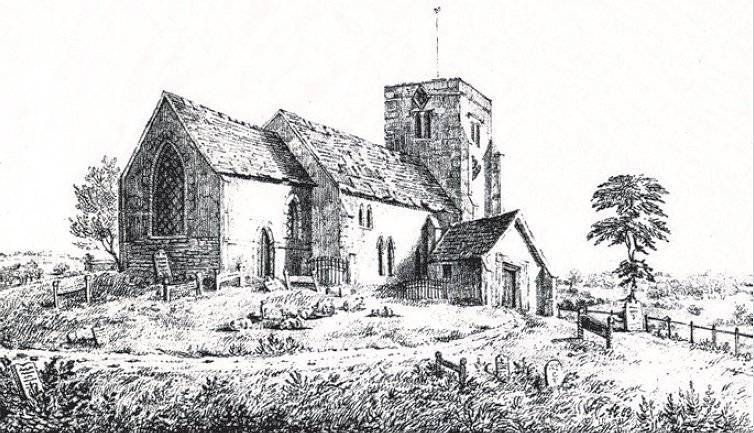17th Century: Archbishop Laud and the Commonwealth
In 1633, Charles I appointed William Laud as Archbishop of Canterbury. He was a fervent High Churchman vehemently opposed to the narrow and destructive tendencies of the Puritan wing of the Anglican Church. He was determined to restore some of the pre-Reformation practices and in so doing made many enemies and even provoked armed revolt in Scotland. He was impeached by the Puritan Long Parliament in 1640 and executed in 1643.
Many churches at this time kept the communion table at the east end of the chancel, but moved it for communion into the middle of the chancel or the nave and turned it east-west. The Puritan view was that it should stay in the body of the church, but then without a Rood-screen it had no protection and was used by all and sundry for their own purposes – by churchwardens for their accounts, by children being schooled, by workmen for their tools and even by dogs relieving themselves. Laud directed that the altar should at all times occupy the same position as the ancient altar and be railed in (usually on three sides) against the east wall, both to protect it and as a visible assertion of its sanctity and mystery. The rails were typically required to be ‘neare one yard in height, so thick with pillars that dogs may not get in‘. The rails were not intended for the convenience of kneeling communicants.
After Laud’s impeachment in 1640, the Long Parliament responded, by appointing commissioners to visit the counties to ‘destroy all images, crucifixes, superstitious pictures and altars or holy tables turned altar-wise that yet remained in churches.’ In 1643, the Commonwealth Parliament passed an Act for ‘the utter demolishing, removing and taking away of all monuments of superstition and idolatry’. This included altars and tables of stone and many altar rails.
In 1637, at the height of Laud’s influence, a Bishop’s visitation of Penn indicates that the communion table was in the chancel and presumably at the east end since it refers to wainscot over it that was in need of repair and of the need to set a board with the ten commandments above it. There was no mention of rails. The visitation revealed a church in a dreadful state of repair and neglect, with broken, partly- boarded windows and seats, a leaking roof and ‘pavements in decay‘. There were three monstrous family pews seven and a half feet high intruding into, the centre aisle of the chancel, and others in the nave and south aisle. There was a reading-seat on the south side ‘so high that it damms up the light of the chancel‘ and a pulpit on the north side.
This neglect was the consequence, typical in Buckinghamshire, of the Puritan irreverence and contempt for the church and all it stood for and the consequent grudging of every penny they were taxed for church purposes. The majority of local gentry and clergy regarded sermons as the only reason for coming to church. There is further evidence of Puritan sympathies in Penn in the survival in office during the Commonwealth of Wllllam Lincke, Penn’s longest ever serving Vicar (1607-61). About one in seven of Buckinghamshire clergy, the ‘scandalous ministers‘, were ejected from their livings after Charles was defeated in 1646, to be replaced by ‘godly, diligent and painful preachers‘. William Lincke was described, in 1649, as ‘diligent‘ and unlike his predecessor, was licensed to preach and is earlier recorded as preaching every Sunday1.
The two leading members of the parish were also clearly sympathetic to Parliament. The owner of one of the monstrous pews in the chancel was Sir Gregory Norton, who was one of King Charles’ judges in 1649, and later signed his death warrant. William Penn, the patron of Penn church was appointed as Sheriff of Buckinghamshire in 1656.
In the 1640s and 50s, during the Commonwealth, the Communion table was required to be back in the nave, often with seats around it. In 1662, after the restoration of the monarchy, the Book of Common Prayer was reluctantly revised in an attempt to find a compromise between traditionalists and reformers. This 1662 version is still in use in Penn. It requires parishioners to take communion at least three times a year and orders that, ‘The table at the Communion time having a fair white linen cloth upon it, shall stand in the body of the Church or in the Chancel… and the Priest standing at the north side of the Table … ‘
A drawing of the outside of Penn church, at about that time, shows a diagonally-leaded east window, narrower than today, with what appears to be plain glass. The medieval stained glass would have been removed at the Reformation or during the Commonwealth.
© Miles Green, August 2003
- My manuscript note records that Lincke’s wife was appropriately named Faith and that he had at least one child, a daughter Elizabeth, baptised 28 June 1610 – (from the BFHS transcript of the Penn Parish Registers.)
Elizabeth married William Alday 31 March 1635 in London. He was from a Penn farming family

